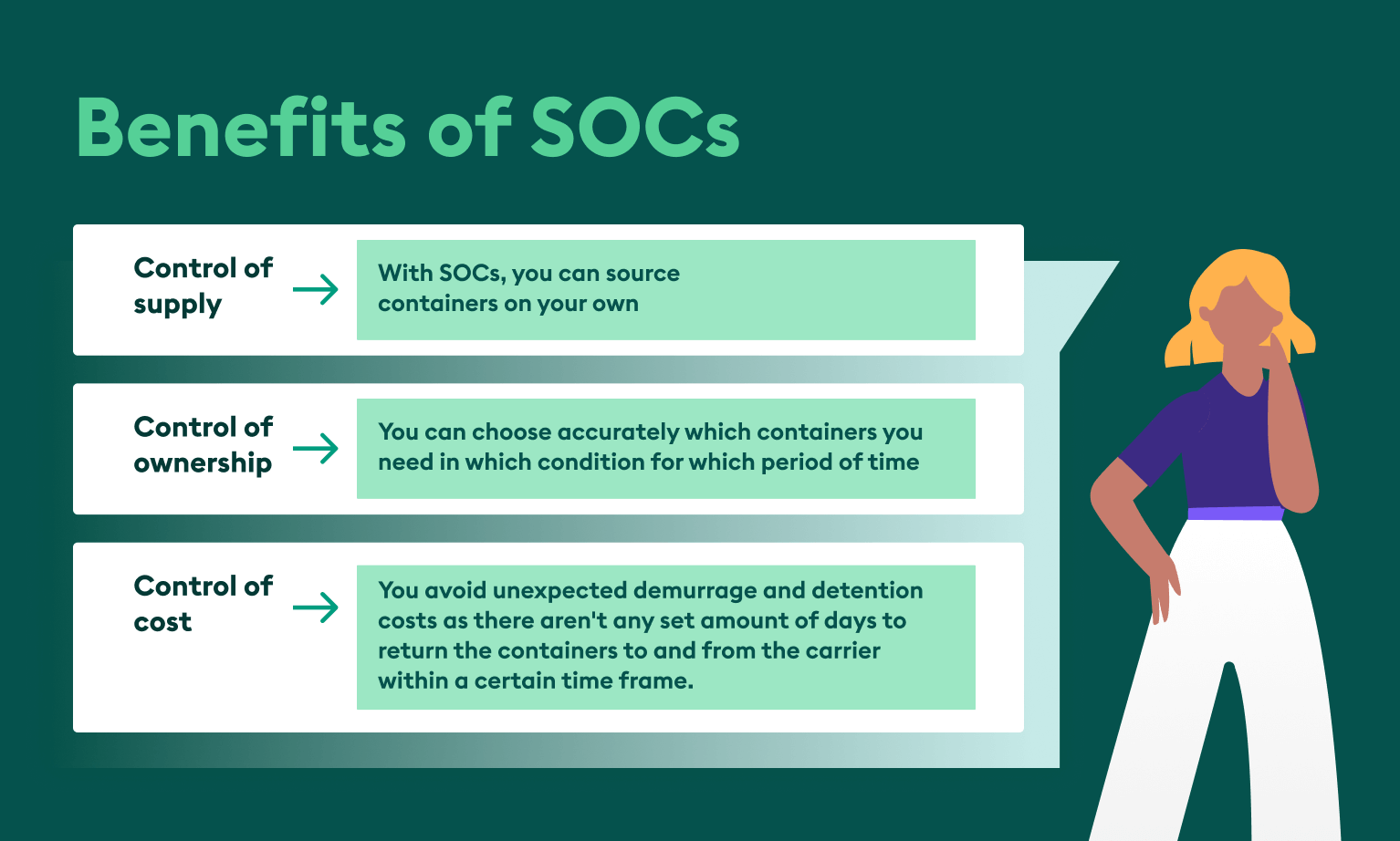The SOC container is known for its reliability and flexibility within the shipping industry. In this blog, we’ll explore the meaning and primary benefits of SOCs and their growing popularity among freight forwarders like you.
As a freight forwarder, your number one priority is to get the cargo to the right place on time while keeping the shipping cost within your budget. But in a dynamic world of logistics, where freight rates fluctuate constantly and equipment shortages are given, relying solely on Carrier-Owned Containers (COC) can be restrictive (and expensive).
This is where Shipper-Owned Containers (SOCs) come in. SOCs help you cut costs, avoid demurrage and detention charges, and give you more flexibility. No wonder, more and more freight forwarders are turning to SOC containers to stay competitive.
Read on to learn what SOCs are, how they help optimize your operations, and where to find the best leasing deals for your preferred routes.
Already know the ins and outs? Use our public search below for the best deals for your one-way moves, or talk to one of our experts for tailored solutions to your container sourcing needs.
25 x 40HC
Container Supplier
Container Company Blurred Name
5
Pick-up charge
User pays
$120
19 Freedays
$44.20 Per diem
What is a Shipper-Owned Container (SOC)?
A Shipper-Owned Container (SOC) is a freight container owned by an individual or business for shipping cargo across long distances. On the other hand, a Carrier-Owned Container (COC) is a freight container owned by a carrier company that is rented out to various consignees.
In simple words, a container is considered SOC when the Beneficial Cargo Owner (BCO), freight forwarder, or NVOCC organizes its own container. So instead of using COC, you bring your own units. With SOCs, the shipper is responsible for acquiring, maintaining, and returning the containers themselves.
When to use SOC containers?
The unavailability of containers, high freight rates, and port congestion make it a perfect time for your shipping business to use SOCs. Let’s understand this in detail:
To avoid demurrage and detention charges
Demurrage and detention charges refer to the fees you pay to the carriers for using their containers beyond the allotted free days. Depending on where you ship your cargo, and port congestion, demurrage and detention costs can start piling up. If you’re looking for a way around this, bringing your own containers (SOCs) will free you from the liability of paying these charges to the carriers. Lease SOCs to avoid hefty D&D charges.
For shipping to distant or remote locations
If you’ve got a substantial amount of cargo to ship to a distant or remote location, leasing SOCs is the best choice. Not only is it cost-effective, but it gives you more flexibility in choosing the route compared to COCs, which only cater to specific popular routes.
To select good-quality containers
By bringing your own containers, you can avoid getting units in poor condition that may not adequately protect your cargo. With SOC, you have more control.
To prevent empty container repositioning
Every year, the shipping industry incurs a huge cost in repositioning empty containers. By finding container users and leasing out SOCs for one-way moves to get them repositioned, you’ll save money on freight rates on empty container repositioning. Not to forget, one-way moves can eliminate container imbalances in areas with surpluses or deficits, thus preventing empty container moves. Container xChange leasing marketplace helps you do exactly that!
To avoid hefty COC charges
Peak shipping season in the US, longer transit times due to rerouting or bad weather, and port congestion can disrupt key trade routes. This causes a spike in freight rates for COCs; by using SOC, you can avoid paying high COC freight rates.
Want to keep up with what’s happening in the shipping industry and how it affects your logistics? Download the report for free today.
How SOCs help freight forwarders cut costs
SOCs help optimize your operations, offering freight forwarders like you an easy way to keep costs under control and stay flexible in a volatile logistics market. Here’s how SOCs help freight forwarders cut costs:
Reducing dependency on carrier-controlled equipment
Let’s face it—carriers call the shots on container availability, which means your options are limited. Plus, you have little to no control over the container’s condition. But with SOCs, you take full control—both in sourcing the container and ensuring its quality. By securing containers independently, you enable smoother operations, fewer disruptions, and better customer service.
Flexible leasing options for one-way move
Whether you need a container for a one-way move or a flexible lease option, SOCs help you find deals that match your shipping routes. The cherry on top? You don’t even have to worry about repositioning empty containers. That means more flexibility, lower costs, greater control, and smoother logistics operations.
Avoiding demurrage and detention charges
With COCs, every minute counts. If a shipment is delayed or containers sit at the port past the agreed timeframe, you could face hefty demurrage and detention charges. SOCs give you breathing room and flexibility—since you bring your own container, you’re not bound by strict return deadlines. That means better budgeting and fewer surprise costs.
How to find SOCs for one-way moves?
Now that you’ve got a sense of the benefits of SOC, let’s take you through how easily you can get them on our platform.
- Log on to our online leasing marketplace
- Type in your preferred route and the container type you require
- Hit the search button and browse through all the offers
- Interact and negotiate deals with vetted suppliers
- Select a deal that suits your budget
Our global marketplace offers 100,000+ containers in 2,500+ locations—making SOC sourcing fast and hassle-free. We also offer an easy and safe payment handling feature, that monitors all payments, streamlines your invoicing, and reduces coordination efforts to pay or get paid when dealing with several partners simultaneously.
The platform is easy to use, but if you still have queries, our expert team is ready to help you resolve them quickly.
So go ahead and connect with 1,700+ vetted container suppliers to get SOCs for your next shipment. Click the banner below to get started.
How freight forwarders can expand their global network with SOC containers
SOCs give freight forwarders like you the flexibility to explore new trade lanes where COC availability is limited. By sourcing SOCs independently, you can move cargo without restrictions, tap into emerging markets, build partnerships, and strengthen trust—ultimately creating a more resilient supply chain.
By now, you know SOCs put you in control. More control means smoother operations, greater agility, and lower costs—helping you expand your global network.
Lease SOCs at attractive rates effortlessly
Looking to lease SOC containers or source them for your existing business? Look no further. Our platform makes it easy to find containers that tick all your boxes—in just a few clicks.
And here’s some good news: the xChange leasing platform is now free to join. You can create your free xChange Network account and start connecting with shipping companies and exploring their offers.
- Enter your requirements, such as the container type and size you need, and get multiple offers from vetted suppliers.
- Compare deals and negotiate terms and conditions directly with the suppliers.
- Make secure payments on the platform without any hidden charges or a middleman.
Sounds quick and easy, huh? But why should you choose xChange? Well, you:
- Access 100,000+ containers in over 2,500 locations worldwide
- Work with 1,700+ vetted and pre-approved suppliers
- Compare multiple SOC offers in one place
- Get container availability insights and price transparency
- Negotiate deals directly with partners—no middleman
Ready to start your SOC journey today? Click on the banner below to see the leasing platform live! Save big, increase your flexibility, take control of your container sourcing, and avoid demurrage and detention fees once and for all—Container xChange.
SOC container: Common FAQs
What are SOCs?
Shipper-owned containers (SOCs) in shipping are containers owned or leased by the shipper rather than the carrier. SOCs provide greater control over logistics and often reduce costs associated with delays like demurrage and detention.
What are the benefits of SOC containers?
Using SOC containers gives you more flexibility to choose the containers that suit your needs, as well as avoiding demurrage and detention fees. SOCs are most cost-effective when there are port delays, congestions, or a lack of COCs in the market.
What is empty container repositioning?
Empty container repositioning refers to moving empty containers from an area with a surplus of containers to a location with a deficit of containers. Moving empty containers is both expensive and inefficient.




